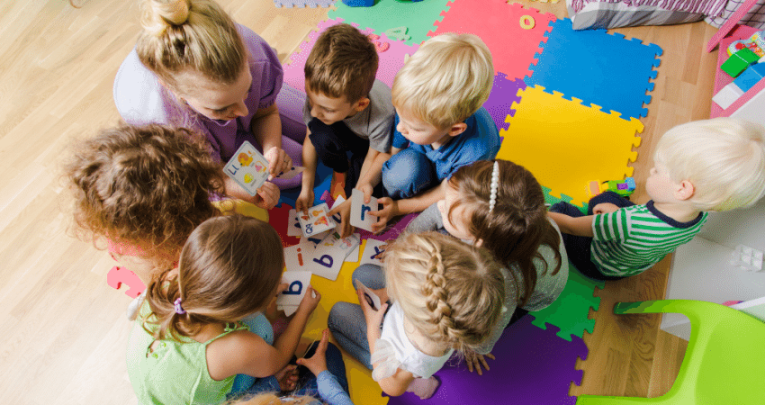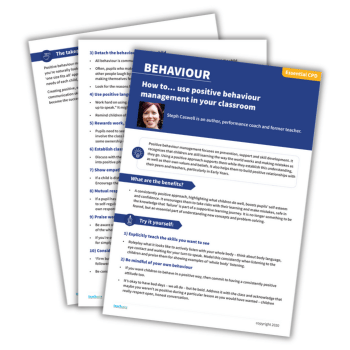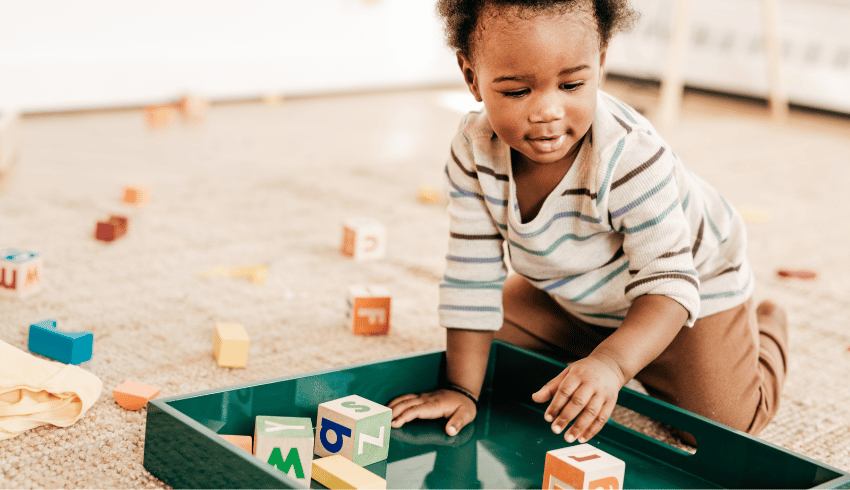Behaviour management in Early Years – Expert tips and ideas

We’ve gathered a selection of expert strategies for managing behaviour to help your nursery run smoothly and let all children get on with learning and having fun…

- by Teachwire
- Classroom expertise and free resources for teachers

Unlock the secrets to successful behaviour management in Early Years settings with these practical tips and creative ideas to help you create a harmonious learning atmosphere.
(We’ve also got behaviour management advice for primary school and secondary school).
What does ‘disruptive’ behaviour tell us?

Before you brand undesirable behaviour ‘naughty’, consider what the child involved might be trying to tell you or learn about the world, says Sue Cowley…
Adults sometimes interpret children’s behaviour as being ‘naughty’ because it doesn’t fit in with our views about how they should behave. But while some behaviour is designed to get an adult reaction, most of the time a small child’s behaviour is simply about an emotion that they cannot express.
When small children feel tired, upset or unhappy, they might ‘act out’ as a result. Similarly, much of what we might term ‘problem’ behaviour is about children experimenting and learning more about their world.
The scenario
Since Tommy started in your setting he has shown an endless fascination for tipping out toys and resources from the boxes in which they are stored. He will move around the nursery, taking each box in turn and tipping everything that is in it onto the floor, or into a large tipper truck that he loves to play with. He then stacks the empty boxes up in a tower, before knocking them over.
“Most of the time a small child’s behaviour is simply about an emotion that they cannot express”
When staff ask Tommy to help tidy up, he is happy to do so. But the minute you turn your back, the resources are tipped straight back out again.
Some members of your staff have expressed frustration about Tommy’s behaviour. A number of other children have begun to copy Tommy and tip out the toys as well. You’re keen to do something to resolve the situation.
The issue
Young children’s behaviour is often simply an attempt to communicate. They do not necessarily have the language they need to express what they really mean.
When you look for solutions to a behaviour issue, consider what the child’s behaviour is trying to ‘say’ to you and your staff team.
Once you have opened up the lines of communication, and figured out what is really going on, you will be in a position to help the child channel the behaviour more appropriately.
Dealing with the behaviour
To deal with Tommy’s tipping behaviour, try the following strategies:
1. Consider what Tommy is trying to ‘tell’ you when he tips up the boxes. Is he saying something to you about the way that he wants to learn? For instance, perhaps he has an interest in a trajectory schema that you could explore together?
2. Ask Tommy’s key worker to spend some time observing him. Then talk together as a staff team about the observations he or she makes. What learning needs does Tommy have, and what next steps could you focus on as a team?
3. Set up situations where Tommy can use his desire to ‘tip out’ things in more productive ways. For example, you could challenge him to count blocks carefully into his truck, to see how many will fit, rather than tipping them all out in a rush.
4. Try offering Tommy some empty boxes and see what he does with them. It could be that he is tipping out the boxes because he is interested in using the empty containers.
Finding solutions
Rather than seeing Tommy’s challenging behaviour as a problem, encourage staff to explore what his behaviour is telling them. How might this lead to ‘next steps’ in learning for him?
- Consider where and when Tommy does the tipping. Although it might feel like the answer to this question is ‘everywhere, and all the time’, it is likely that there is something that triggers this behaviour.
- Encourage staff to talk to Tommy about why it might not be appropriate to tip out the toys. Ask him what the problems might be with him doing this. Could someone trip over them, or perhaps the toys and resources might get damaged?
- Talk to Tommy’s parents about whether similar behaviour happens at home. If it does, talk to them about how they deal with Tommy when he demonstrates his tipping-out behaviour. Perhaps Tommy behaves like this to get their attention.
- Explore ‘tipping out’ different resources with Tommy. For instance, he could experiment with tipping out water from one size jug into another in the water play area. Or he could tip soil or sand into containers in an outdoor area.
- Encourage Tommy to tip resources from one box into another, rather than directly onto the floor. Talk to him about how this helps you keep your setting safe and tidy, and why this is important.
Sue Cowley is an author and teacher trainer. For more information, visit suecowley.co.uk.
How to tackle inappropriate language

We all want to encourage talk – but when the language used is inappropriate, it’s important to take action to resolve the issue, says Sue Cowley…
As we grow up, we all need to learn about what is and isn’t ‘appropriate’ behaviour in different situations. For small children, there is sometimes a gap between behaviours parents have modelled at home and what is viewed as appropriate in an early years setting.
One particular issue can be where a child picks up on inappropriate language and then brings it into the setting. As practitioners, we need to help children learn what is and isn’t socially acceptable in a variety of contexts
The scenario
Daniel was very quiet when he first arrived at your setting, but after a few weeks he started to come out of his shell. As he became more confident, you were surprised by some of the language he began to use.
“An important part of your role is to help children control their impulse”
He wasn’t exactly swearing as such, but you heard him call one child a “poo-poo head” and shout “bum” at another, when he was angry about being left out of a game.
You had hoped that this behaviour might be a one-off occurrence, but Daniel has now unfortunately started to use similar words several times a day, whenever he gets frustrated. You’re not quite sure what to do next…
The issue
Young children often experiment with using language in inventive ways, especially when they realise that the words they use get a reaction. If the reaction they get is one of shocked disapproval, this may well exacerbate rather than resolve the issue.
Children tend to model the language they hear. They will pick up on what the adults around them say, as well as the language of friends and older siblings. A certain level of experimentation is normal, as young children get used to what is and is not socially acceptable in different situations.
However, an important part of your role is to help children control their impulses and adapt their behaviour to suit the context.
Dealing with the behaviour
To deal with Daniel’s fruity language, try the following strategies:
1. Devise a coordinated response. As a staff team, discuss how you are going to react and respond when Daniel uses inappropriate language. Decide on a consistent approach that will be used by all members of staff at your setting. For instance, a staff member could ask Daniel to step away to one side for a moment, and discuss why his behaviour is not okay.
2. React calmly. Daniel seems to be looking for a reaction, so it is important for staff to respond calmly. The more he gains attention for inappropriate language, the more likely it is that he will repeat the behaviour to receive the reaction.
3. Talk to him. Encourage staff to talk to Daniel, to help him understand why these words are inappropriate. Ask him to think about how it feels for the other children when he says these things to them.
4. Praise Daniel’s good behaviour. Ask staff to focus on praising Daniel when he behaves well, rather than focusing on him only when he behaves inappropriately.
5. Raise the issue with the other children. It might also be useful to talk with all your children about how we use ‘kind words’, and how we make sure that we don’t say anything that might upset someone else.
Finding solutions
To help find a solution, it would be useful to identify why the problem is occurring. You will also need to help Daniel understand, manage and control his own behaviour.
- Talk to Daniel’s parents about what is happening, and whether there might be something going on at home that is causing it. Could Daniel be hearing these words from an older sibling, and if so, could they have a word with the older child?
- Consider whether Daniel’s use of toilet-related language could be something to do with toilet training. Perhaps he’s uneasy about using the toilet in your setting and is trying to cover up for his embarrassment?
- Talk to Daniel about other ways in which he can express his frustrations. For instance, in future he could walk away from a child who is upsetting him, or talk to his key worker about how he feels.
- Help Daniel figure out different ways to stop himself reacting instantly when he gets frustrated, such as counting to ten or breathing deeply.
- You might want to try using a star chart to reward Daniel for each day he manages to not use any rude words.
Tackling behaviour as a team

If you want children to abide by your rules, you need to keep them consistent across your setting, says Sue Cowley…
One of the most important factors in effective behaviour management in Early Years is having a consistent approach across your whole team. This can be difficult to achieve, because people have their own ideas about what ‘good behaviour’ looks like and how best to go about getting it.
It’s important for children to be clear about what the ground rules are in your setting and to receive a consistent response from different staff members if they don’t follow those rules. This helps them feel safe and secure during their time with you.
The scenario
At a recent staff meeting, one of your practitioners complained about inconsistent responses to children’s behaviour.
The discussion got quite heated, with some people commenting that staff ‘let the children get away with’ being naughty. Others complained about the ‘old-fashioned methods’ used by other team members.
You want to establish a clear vision around behaviour and ensure everyone is singing from the same hymn sheet.
Creating clarity
If we want children to learn to behave well while in our care, they need to know what ‘behaving well’ looks like. We must communicate this to them so they understand, helping them learn why certain behaviours are welcome and others aren’t.
“Others complained about the ‘old-fashioned methods’ used by other team members”
Consistency across your team is crucial – the last thing you want is to send mixed messages about what is and isn’t okay. To achieve clarity you need buy-in from the whole staff team. Ask yourself…
- Does everyone in your setting have a genuine chance to give input into your behaviour policy? How often do you revisit your policy to develop it?
- Do you have a clear set of guidelines for behaviour? Do all staff agree they are the correct ones?
- How do the children know what you expect – do you reinforce guidelines regularly, are they on display, do you send information home, etc?
- How often do you talk about the ‘why’ behind the behaviours you want – do the children know why you are asking them to behave like this?
- When a child is being difficult, do all staff know how to reflect on what their behaviour might be communicating and the adaptations that might need to be made for them?
- How do parents feel about behaviour in your setting, and how do you support them to use the most effective approaches at home?
Agree to disagree
There will always be differences of opinion around the subject of behaviour, and thinking on best practice has changed considerably over the last few decades. Some people seem to be ‘naturals’ at handling young children’s behaviour, while others find this aspect of their role challenging.
Give staff a chance to have input into your policy, but once the team has agreed on their approach, make it clear that all must work to these expectations, for the benefit of the children.
For anyone who is really struggling, set targets to revisit at appraisal and offer additional training to support their personal development.
Achieving consistency
When tackling behaviour, what you are trying to do is create an invisible sign over the door to your setting that says, ‘This is how we do it here.’ To achieve this…
- Work together to create an unambiguous agreement about the team’s vision for behaviour in your setting.
- Talk to the children about what they think ‘good behaviour’ looks like, and take their ideas into consideration.
- Check all staff understand why consistency is important and, if they don’t, keep revisiting this idea.
- Where there is a difference in philosophy between practitioners, be clear that they must focus on the setting’s vision, not personal opinions.
- Model the approach you expect, so staff can see what it looks like in action.
- Make time for regular discussions about the best way forward with individual children.
Remember, being consistent doesn’t mean being inflexible or taking a ‘one size fits all’ approach to behaviour. You can have consistent aims and standards but still find flexible ways of achieving them, ones that are responsive to the needs of each individual child.
How to tackle tantrums

Emotional meltdowns are to be expected from children under five, but there are ways we can tackle chronic overreaction, says Sue Cowley…
The younger a child is, the more likely they are to become caught up in the whirlwind of their own emotional and/or physical state. If a small child is tired, unhappy, hungry, anxious or feeling stressed, this may result in what we refer to as ‘difficult’ behaviour.
The inability to deal with stress or upset might be expressed via a tantrum, but equally a child could also become withdrawn and unresponsive.
Helping children learn how to regulate their own internal reactions is a key part of helping them build an understanding of what is and isn’t appropriate behaviour in different situations. At the same time, we must be clear with them that it is OK to express their feelings.
The scenario
One of your new starters overreacts to every tiny problem. She clings to her dad’s leg when he goes to leave. If she can’t play with the toy she wants, she has a tantrum. She gets very grumpy indeed towards the end of the morning session, and bursts into tears when her dad arrives to pick her up.
“We must be clear with them that it is OK to express their feelings”
You want to support her through her outbursts, but you worry that by doing so you might encourage her to have more of them.
Nothing more than feelings
We must strike a delicate balance when comforting children who are in the throes of emotional upset. If we react too quickly, and focus too much on that moment of emotional reaction, we may encourage the child to see expressions of anger as a means to gain attention.
You should always comfort an upset child, but there are many strategies you can use to help them develop self-regulation as well.
Pre-empting behaviour
When dealing with behaviour, consider why it is happening, because that can help us figure out how we might prevent the situation occurring in the first place. For instance, in the scenario above…
- Consider how you could make the transition into the setting easier for the child – could a practitioner guide her towards some toys, or read to her, to help her make the separation from Dad?
- Let Dad know you would always call if the child remained upset, and encourage him to make the break easier by leaving decisively. Alternatively, perhaps he could stay and play a while to support her?
- Think about why the child is getting grumpy towards the end of the morning and what you could do to counteract this. She’s probably tired, so could you incorporate a restful activity at this time of day? Do you have a quiet space where children can relax?
Distracting
When a child is tantruming, it’s difficult to resist doing everything you can to quieten them down. Of course you want to comfort the child, but if you always do all the work, the child never gets the chance to calm themselves.
It can work well to distract them from their anger, particularly if they are prone to tantrums. You might…
- Suddenly notice an exciting toy, drawing it to the child’s attention in an enthusiastic voice
- Get everyone together to do a quick physical activity, such as ‘heads, shoulders, knees and toes’
- Move towards the child, but give your attention to a child in their proximity first, who is playing calmly, before you talk to the former
- Encourage the child to take deep breaths – the out-breath is particularly important in calming children and helping them not to hyperventilate
- Set up games/activities in which they need to cooperate and share to be successful
- Encourage them to focus for gradually increasing periods, for instance, during a show-and-tell session, or at storytime
- Catch them just as they seem to be getting upset and suggesting self-calming measures, such as taking deep breaths or walking away
- Use some ‘mindfulness’ activities, where the children have to pause and be still, such as ‘statues’ or ‘sleeping lions’
Dealing with over-excitement

Kids should be excited about learning, but they can quickly and easily slip into ‘excessively overexcited’ if left unchecked, explains Sue Cowley…
The scenario
One of your staff has a knack for getting the children overexcited. Wherever she is in the setting, there is always lots of noise and a feeling that things are on the verge of becoming unsafe.
The fevered atmosphere she creates has a habit of rippling through the setting. You don’t want to dampen her enthusiasm, but you need to ensure that the children are kept safe. You want to help her understand how to keep things a little bit calmer.
A model of calm
It’s gratifying to see children laughing and getting excited at something that we do with them, and it is lovely when practitioners can maintain a childlike enthusiasm for the world.
“When you work with small children, you ‘make the weather’”
However, when we’re working with children we must always be able to take a step back from what we’re doing and act as the adult. If we want to get calm behaviour from the children, we need to model it for them.
If we want to encourage calmer behaviour from adults, we need to help them understand why it’s important.
Practical steps
1. At your next staff meeting, talk about the importance of modelling a calm approach for the children, to ensure their safety. You could link this to revisiting and updating risk assessments.
2. Give your team some input on the kind of verbal and non-verbal interventions they can use to keep things calm (see below). It can be useful to model some scenarios and to get staff to explore how they would deal with them. For instance, calming an overexcited child, or handling a child who is in the throes of a tantrum.
3. Talk to the individual staff member about how lovely it is to see the children getting so excited when she plays with them. Explain to her, though, that their safety must remain her first priority. You could set this as a target to revisit in an appraisal.
4. Look at the layout of your setting, and the kind of activities and resources you have in the different areas. Consider whether the overexcitement could in part be a reaction to the way you plan your continuous provision.
5. When you set up each area of your provision, consider how excited the children are likely to be in response to it. Aim to balance any ‘exciting’ options with opportunities for calm, quiet learning.
How to create calm
When you work with small children, you ‘make the weather’ – the children will behave differently according to the way that you use your body, your face and your voice. Learn how to control your verbal and non-verbal communication, to encourage a sense of calm.
- Consider how loudly you speak, and whether this level of volume is necessary. We often speak more loudly than we need to, perhaps when we’re trying to communicate enthusiasm, or to try and get the children’s attention. Unfortunately, a loud volume tends to ramp up the excitement levels.
- The quieter you speak, the quieter the children have to be to hear you. Make a conscious effort to lower the volume at which you speak and notice how it draws the children in.
- Although an enthusiastic tone of voice is useful for engaging the children, when we want to calm them down it’s best to use a fairly flat tone. Experiment with removing the tone from your voice to see what kind of atmosphere this creates.
- A low pitch tends to communicate relaxation and calm, whereas a high pitch can cause a feeling of tension or overexcitement. Relax your neck when speaking, to help you pitch your voice low.
- Model a calm and relaxed posture and body language, keeping your movements slow and considered.
- Bring yourself down onto the same level as the children, and gently encourage them to make eye contact when you’re talking with them.
How to improve behaviour with reflective language

Reflective language allows you to acknowledge and validate children’s feelings, boosting self-esteem and improving behaviour in one fell swoop, says Cath Hunter…
Carol, a nursery worker, came to see me as she was concerned about Matthew, who was four. He was very loud and talkative at nursery, constantly interrupting and talking over both adults and children, and found it very hard to sit still.
He had three teenage siblings and the house was often very busy and loud. Matthew had learnt that he needed to be loud to be heard, and to interrupt to ensure he was listened to. So I encouraged Carol to try ‘reflective language’ with him…
A strong and positive message
Reflective language is a subtle way of providing positive messages to a child. It conveys to the child that you are seeing them, trying to understand them and acknowledging any feelings they may be experiencing. It also provides an opportunity to tentatively explore what may be happening for a child – for example, “It can feel frustrating when we get things wrong.”
This way, adults can gently explore the child’s experience without making judgements or assumptions about it. On this particular occasion, I suggested that Carol acknowledges to Matthew how difficult it was for him to wait and to reflect: “I can see it’s tough for you to listen to other people and wait for your turn to talk, but I can help you to practise that and you will always have your time to talk.”
“Reflective language is a subtle way of providing positive messages to a child”
This reflection gave a strong and positive message to Matthew that he was worth thinking about and trying to understand. I encouraged her to talk to him afterwards, and to identify and praise each time he was able to wait to talk by reflecting: “I could see that it was so hard for you not to talk when we were listening to Jodie, but you did really well at waiting until it was your turn.”
This acknowledges his struggle, identifies what he is trying to do and validates his behaviour, which encourages him to continue trying with something that he has found difficult.
The benefits
There are many advantages to using this type of approach with children. Firstly, it clearly communicates to a child ‘I see you, I hear you, I am trying to understand you’, enabling them to feel seen, heard, valued and understood.
For some children, this can be a relatively new experience, offering a positive way of building a connection and developing a relationship with a child.
Using words such as ‘perhaps’, ‘maybe’ and ‘sometimes’ in our interactions, for example, enables children to agree or disagree if they want to, rather than the adult deciding how the child may be feeling.
Commentary
It also provides a commentary of their behaviour – for example, “I can see you are working really hard trying to fit those pieces together.” By using this with children, adults are providing a positive message to them: ‘You are worth thinking about and trying to understand; I am trying to help you to work out how you feel and support you with understanding and managing your feelings’.
- 1. Communicates empathy
- 2. Shows understanding of what the child may be experiencing
- 3. Tentatively explores possible feelings
- 4. Describes the situation
- 5. Offers help and maintains boundaries
It also promotes emotional health and wellbeing by validating the child’s emotional needs, and acknowledges the child’s experiences and feelings. As there is no judgement attached to these comments, it enables the child to feel accepted and therefore builds confidence, self-esteem and promotes a sense of self-worth.
Using this approach with children also enables adults to reflect on the possible reasons for their behaviour, whilst maintaining clear and firm boundaries with them. For example, “I can see that you are getting really cross; you look furious, but it’s not OK to hurt other people. We need to find another way for you to have your feelings and not hurt anyone.”
“Using this approach with children also enables adults to reflect on the possible reasons for their behaviour”
This response provides a clear message to the child that they are important, because it is validating rather than dismissing their feelings and offers the child support with expressing them. It can be a powerful tool to change children’s behaviour.
In practice
Reflective language can be used throughout the day, by thinking about and commenting on what is happening and tentatively exploring what a child may be experiencing.
For instance, if a child is struggling or finding a task difficult, it can help to reflect, “It can be difficult when we get things wrong” or “It can feel frustrating when we are trying to do something and we can’t work out how to do it.”
This enables the child to feel noticed and understood, along with helping them to identify how frustration feels.
- ‘I’ve been thinking about how hard it is for you to sit on the carpet… ‘ You are worth thinking about
- ‘I’m going to ask Mrs. Jones to spend some time with you and teach you how to put your coat on; I can see it frustrates you when you try to do it…’ You are worth helping and your feelings are important
- ‘It’s important that everyone has a turn at being at the front of the line…’ Your needs matter
- ‘It can be really difficult when you are playing on the bike and it’s someone else’s turn…’ You are important
- ‘I can see you look unsure about what to do…’ You are worth noticing
Gradually, this will enable the child to link the feeling with the word and to make that connection themselves – which may in turn enable them to use the word themselves when they next have that feeling. It helps if staff can use this and comment on their own feelings – “I felt sad when I was unwell and missed the school trip,” for example.
Reflect rather than reprimand
It’s beneficial to use reflective language rather than reprimanding children, because as highlighted above, it acknowledges and validates their feelings and experiences.
It provides the children with a very positive message about themselves, reinforces that the child is important as an individual in their own right, and provides a clear sense of acceptance of who they are as a person.
It’s an approach that promotes awareness of children’s own emotions, along with sensitivity to the emotions of other people, with the result that they will have an increased ability to put those feelings into words.
Using reflective language enables children to feel seen, heard, valued and understood – all essential ingredients to build their confidence and self-esteem.
Like anything new, using reflective language may feel strange at first, and you may not see instant results. But keep practising and persevering, and I am sure you will see it can make a positive difference to children.
Cath Hunter is is a therapeutic consultant, trainer, play therapist and author of Understanding and Managing Children’s Behaviour through Group Work Ages 3–5. For more information, visit therapeuticfamilyinterventions.co.uk or follow @CathTFI.
Should you use distraction to manage behaviour?

Distraction is often recommended as a method of controlling child behaviour – but is it the best choice? Sarah Ockwell-Smith explores the issues…
Imagine that you’re watching three children playing together. They are getting along well, each racing a car around a make-believe track.
One child decides she wants to use a car that one of the other children is using. The other child is not keen on giving up his car, however. It soon becomes clear that the situation is not going to be resolved amicably without adult help.
What would your response be? Many adults would suggest that the child selects a different car. They might say, “Look at this shiny red car! Why don’t you play with it instead?” Or perhaps they’ll suggest something completely unrelated – “I’m going to get everyone a snack now, would you like to help me?”
Whatever the suggested solution, it will likely involve distracting the child with another, seemingly more attractive option – the idea being that the alternative will be so appealing to the child, that she will forget her upset at not being able to do whatever she wanted to do initially.
This might seem like a solution that keeps everybody happy. It will keep the adult and the other children happy, certainly. But what about the child who was distracted? How does she feel?
Scenario
Imagine the following scenario: you’ve just found out that your partner has been having an affair. You are heartbroken and call your best friend to ask if they can meet you for some moral support. You agree on a meeting point at a local park.
“But what about the child who was distracted? How does she feel?”
Some time later you are sitting on a bench with your friend. You start to pour your heart out about the devastation you feel, then start to cry in big heaving sobs. Now, you have two options to pick from, regarding how you would like your friend to respond to you:
a) Your friend puts her arm around your shoulder, tells you that she’s listening and to tell her everything. She sits quietly while you speak and listens. You cry until you feel you cannot cry any more, letting all of your emotions out.
b) Your friend puts her arm around your shoulder, smiles at you while looking into your eyes and then shouts, “Squirrel! Look, it’s a squirrel! Can you see it? Shall we go and look at the squirrel?”
Which option would you pick? The first may ‘cause’ you to sob for many minutes. The crying, however, is healing, despite the outpouring of emotions. Your friend listens and you feel able to show her your true feelings, knowing she will support you with them.
In contrast, the second will probably stop you crying quickly, once you get over your initial confusion. It will almost certainly take your mind off of your upset temporarily.
Dismissal
The problem, however, is the dismissal of your feelings – or more specifically, the dismissal of your feelings and the lack of help and support to help you cope with them, because the distraction is solely in favour of the person suggesting it.
While I’m not suggesting that distraction should never be used, it should be kept to a minimum.
“The distraction is solely in favour of the person suggesting it”
There will be situations when you will need to distract children, for the benefit of others. There will be situations when you do not have the time or the resources to fully support the child with their feelings.
These situations should be viewed as emergencies, a response to use when you have absolutely no time and resources available to respond in any other way.
Modelling behaviour
Why does it matter that children are supported with their feelings?
Aside from feeling listened to and understood, children learn emotional intelligence from experience. If they are not given opportunities to work through their feelings, they’ll find it much harder to regulate them when they grow.
Children learn from real-life experience. Not only does being supported through their difficult big feelings help them to learn how to control them, it also provides a great role model for them to follow.
If children spend time with adults who regulate their emotions well – particularly emotions such as anger, frustration and irritation – they slowly learn how to imitate emotional intelligence.
“Children learn emotional intelligence from experience”
Distracting children does not make for a good role model, or a good learning opportunity.
As adults, we may feel that by distracting we are sparing children’s feelings and preventing upset that they don’t necessarily need to experience. In many ways we are scared and intolerant of their emotions. The minute they cry, we try to stop them – but we should ask ourselves why we are trying to stop the emotions. For whose benefit is it?
Supporting adults
Sadness, anger and frustration are all legitimate emotions. It’s OK for children to feel them, it’s OK for them to cry and get mad.
The role of supporting adults should always be to support, not ignore, wherever possible. So how should you support children to manage the big feelings they experience? I like to use the acronym ‘SENSE’. the meaning of which is outlined below.
While this sort of response may not be ‘common sense’ (largely because we’re so trained to cover up feelings in our society today), I hope you’ll agree that it does indeed make sense when it comes to helping children in their emotional development.
“Sadness, anger and frustration are all legitimate emotions”
SENSE requires a degree of one-to-one interaction, so I appreciate there will be times when distraction has to slip into your practice. So long as these times are in the minority, that’s just fine.
Using the SENSE strategy to manage big feelings
• Safety always comes first. The safety of the child, other children in your care and sometimes the objects around you. If necessary, move with the child to a calmer space.
• Empathise. The child isn’t behaving in this way to be ‘naughty’, only because he doesn’t have the brain development necessary to behave in a more socially acceptable, mature way.
• Name the child’s feelings. “I can see you’re angry that you can’t have the car.” This helps the child to feel ‘heard. In time children may be able to ask for help by naming their feelings.
• Support the child. As difficult as it is to cope with the child, it’s much harder for them to cope with their feelings. Try to work as a team to help the child feel safe and supported.
• Exchange. Only at this point, once the child is feeling validated and understood, can you offer an alternative, such as “I can see you’re really sad, would you like to read a book with me?” Distraction comes last, not first.
For more information, visit sarahockwell-smith.com or follow @TheBabyExpert.







